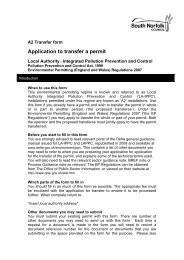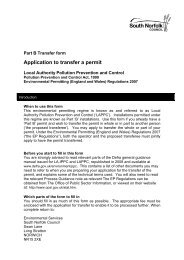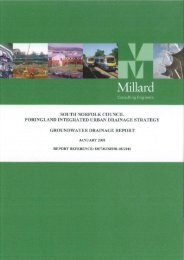have a look at this bee factsheet and see what best describes your ...
have a look at this bee factsheet and see what best describes your ...
have a look at this bee factsheet and see what best describes your ...
- No tags were found...
You also want an ePaper? Increase the reach of your titles
YUMPU automatically turns print PDFs into web optimized ePapers that Google loves.
The nest dies out during l<strong>at</strong>e summer/early autumn, only the queen surviving until thefollowing spring.Bumble <strong>bee</strong>s are harmless <strong>and</strong> will only get agit<strong>at</strong>ed if the nest or its entrance is disturbed.Unlike honey <strong>bee</strong>s they do not swarm.Honey <strong>bee</strong>sThe honey <strong>bee</strong> is the only <strong>bee</strong> in <strong>this</strong> country which swarms <strong>and</strong> theswarming season is usually from mid-April until early August, with May<strong>and</strong> June being the months when swarming is <strong>at</strong> its gre<strong>at</strong>est.Several days before a swarm emerges from the hive "scout <strong>bee</strong>s" willfly <strong>and</strong> find various new sites for the swarm to go to <strong>and</strong> it will be oneof these sites th<strong>at</strong> the swarm will establish a new colony. It is notuncommon for people to mistake <strong>this</strong> "scouting" especially aroundchimneys, for actual swarms.A swarm will only leave the hive if the we<strong>at</strong>her is right <strong>and</strong> <strong>this</strong> is usually on a bright sunny<strong>and</strong> warm day with little or no wind, normally mid to l<strong>at</strong>e morning is a favourite time.Swarms are easy to spot as there are several thous<strong>and</strong> <strong>bee</strong>s <strong>and</strong> it will usually be as large asa football, sometimes larger <strong>and</strong> they all hang as one mass when they <strong>have</strong> settled. Solitary<strong>bee</strong>s <strong>and</strong> bumble <strong>bee</strong>s never swarm <strong>and</strong> compared with honey <strong>bee</strong>s there are only a few ofthese flying <strong>at</strong> any one time.Places where swarms settle are:branches of trees <strong>and</strong> shrubsin or on the outside of hedgesinside garden compost bins assuming there is spaceinside chimneys/central he<strong>at</strong>ing fluesin the cavity wall of a buildingon the outside wall of a high building.If the trees/hedges/compost bins are reasonably accessible the <strong>bee</strong>keeper should be able toremove the swarm without too much difficulty. It is almost impossible to remove honey <strong>bee</strong>sfrom a chimney or cavity if they <strong>have</strong> <strong>bee</strong>n there more than 2/3 days, as in th<strong>at</strong> time they will<strong>have</strong> started to build comb <strong>and</strong> establish themselves. They will probably survive until thewinter but because of lack of food or disease will die before spring. If it is necessary to destroythe <strong>bee</strong>s then <strong>this</strong> has to be done by a pest control company, <strong>bee</strong>keepers are not killers ofhoney <strong>bee</strong>s.



![List of outstanding appeals against planning decisions [PDF, 30 Kb]](https://img.yumpu.com/51294693/1/190x135/list-of-outstanding-appeals-against-planning-decisions-pdf-30-kb.jpg?quality=85)



![Brown bin calendar - week 2 [PDF] - South Norfolk Council](https://img.yumpu.com/49352110/1/184x260/brown-bin-calendar-week-2-pdf-south-norfolk-council.jpg?quality=85)



![Link magazine, Spring 2008 [PDF, 4,450k] - South Norfolk Council](https://img.yumpu.com/43994858/1/184x260/link-magazine-spring-2008-pdf-4450k-south-norfolk-council.jpg?quality=85)

![South Norfolk Council Volunteering Opportunities [PDF]](https://img.yumpu.com/42079564/1/184x260/south-norfolk-council-volunteering-opportunities-pdf.jpg?quality=85)
![Tiffey Valley Guide [PDF, 1,450k] - South Norfolk Council](https://img.yumpu.com/41615145/1/124x260/tiffey-valley-guide-pdf-1450k-south-norfolk-council.jpg?quality=85)
![Queen's Diamond Jubilee Fund [PDF] - South Norfolk Council](https://img.yumpu.com/41088331/1/184x260/queens-diamond-jubilee-fund-pdf-south-norfolk-council.jpg?quality=85)
